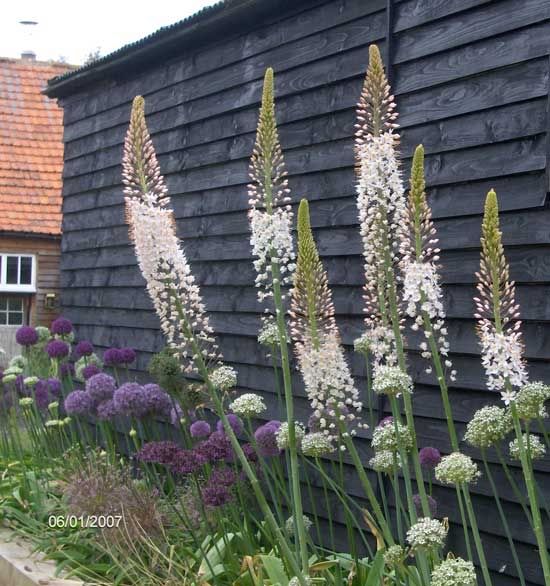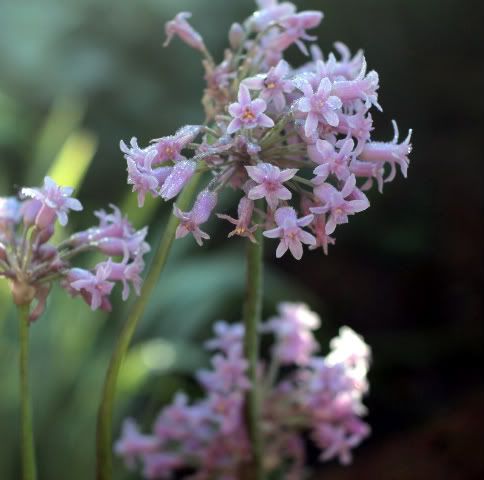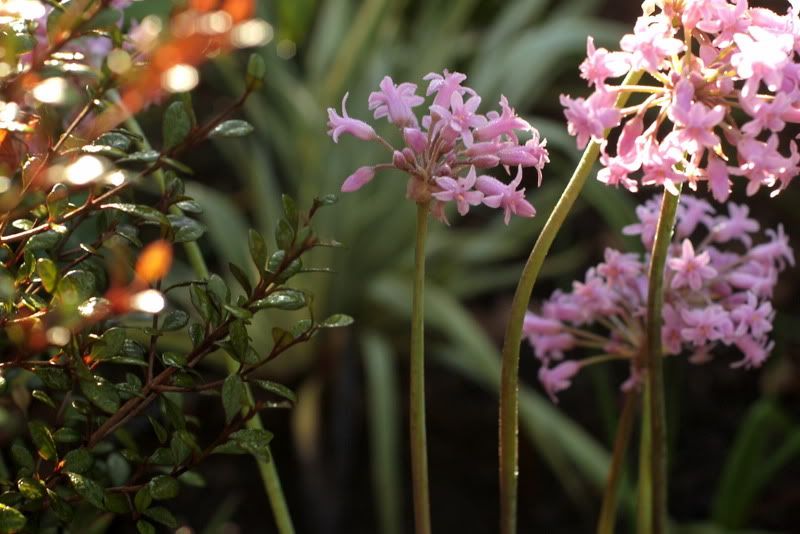I haven’t seen the movie ‘Black Swan’ yet, but sometimes I wonder if my own search for the ideal plant isn’t reminiscent of the exacting standards of ballet.

For my tiny garden, my ideal summer-flowering plant is tall and slim, occupies very little ground, and dances in the breeze. Similar to an agapanthus…but emphatically not an agapanthus. Balanchine’s ideal of the perfect ballerina, which he found in Suzanne Farrell, insisted she be tall (Farrell was 5-8), have a small head, short torso, long thin arms and legs. The Ideal inevitably leads to conflict, more so when imposed on people rather than plants. Just this past December, an ungallant comment by the NY Times dance critic in his review of NewYork City Ballet’s performance of Balanchine’s The Nutcracker (“the Sugar Plum Fairy looked as if she’d eaten one sugar plum too many“) provoked a week of outrage on daytime talkshows.
Balanchine’s Ideal

My Ideal

(Eremurus and allium photo from Rose Cottage Plants)
Looks like Balanchine and I are after similar ideals (a dancing foxtail lily?)
Agapanthus should easily fulfill my ideal, possessing the plant architecture of a robust allium. Omnipresent in Southern California, agapanthus are completely solid, reliable performers. It’s understandable that such a beautiful plant, although ubiquitous here, should be so desirable elsewhere, and there is possibly a hint of stubborn snobbery in my avoidance of them. Dan Hinkley grows no less than 65 species of agapanthus at Windcliff, and I’m certain my ideal must be among them, preferably of the darkest blue and not a huge mophead of a bloom, please. I admire their elegant line in bloom but am annoyed by their smug, strap-leaved, creeping ways. But more and more I am able to envision them in containers backed by aralias, arundo. It’s not a plant’s fault if it’s been hopelessly suburbanized.
I love the surge of excitement blooming plants provide as they grow and develop, yet my garden seems headed in the opposite direction, the year-round presentability that’s possible in a mediterranean zone 10, all shrubby and grassy. Which is fine for commercial landscapes or non-gardeners, but the plant-obsessed demands more from a garden.
Sounds like an impasse. Eremurus won’t grow in zone 10, the big alliums are iffy, agapanthus and I still have issues to work out, but there’s…tulbaghia?

Tulbaghia simmleri
With trembling hands, I pulled this unnamed tulbaghia species, some blooming white, some lilac, from a nursery table earlier this week. Earlier in the year I’d come across a blog post (Interleafings?) that referenced an exciting tulbaghia species with bigger flowers, strappier leaves than society garlic, so I knew it was out there. This description from the Pacific Bulb Society fits my mystery tulbaghia perfectly:
“Tulbaghia simmleri which has sometimes in the past been listed as Tulbaghia fragrans is one of the showiest species with strap shaped leaves. Found in the same areas in the wild as Clivia miniata it is sometimes called Sweet Garlic or Pink Agapanthus. It is sweet smelling and the leaves look a bit like Agapanthus leaves. It generally has light purple (lilac) flowers, but a white form exists, as does a pink one with a white corona. Planted in my Mediterranean garden where it probably doesn’t have enough moisture in summer and maybe too much in winter, it still often blooms twice a year, in the spring and the fall. I’ve had the same plant for many years and it has never increased at all.”
Another intriguing, evergreen possibility can be found in Yucca Do’s catalogue, which currently lists an onion, Allium canadensis var. hyacinthoides, that sounds promising. I may sound like a garden Svengali, but these slim shapes rising out of a shrubby, chapparalesque setting have evolved in mediterranean landscapes all over the world, although often found in the form of summer-dormant bulbs. So I’m not concocting a garden fantasy out of whole cloth, just tweaking an ecosystem’s example a bit.

We all nurture a vision of the ideal, and one of my favorite pastimes has become reading the blogs of gardeners wrestling with their own vision, tempered by geography and climate. And it’s not unusual to seek out certain shapes: Piet Oudolf favors umbellifers, understandably so, beautiful as they are in youth and decay. I do love plants for their own sake, not just as abstract components in a design, but to argue against one over the other, plants vs. design, creates a false dichotomy, as though we stand in opposing barbarian camps, brandishing torches and spears at each other, an oversimplification I don’t subscribe to. But that’s another post entirely, tentatively titled: Do you buy the pot first and then wonder what to put in it, or does the plant come first? (I routinely do both.)

I like Tulbaghia, except right after our first deep freeze when the whole garden smells of garlic gone bad. How about a Kniphofia or the near-weedy Verbena bonariensis.
Good suggestions, Les, and I’ve been including both the verbena and kniphofia. This species tulbaghia doesn’t seem to have the stink of society garlic so far.